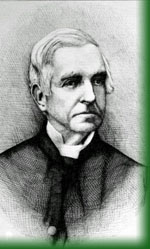
Thomas Brock Fuller's
Early Years
On Niagara Becoming
an Anglican Diocese
T. B. Fuller Becomes
First Bishop of Niagara
From
The Bishops of the Church of England in Canada and Newfoundland
by
Charles Henry Mockridge
published in 1896
First Bishop of Niagara


Archdeacon Fuller, of course, had been very active in the formation of this new diocese, and it was a foregone conclusion that he would be the first Bishop.
At the election which was field in Hamilton on the 17th of March, 1875, he received 32 clerical and 33 lay votes, the numbers necessary being 26 and 23 respectively.
Dr. Fuller was consecrated on the 1st of May, 1875, in St. Thomas' Church, Hamilton, by the Most Rev. the Metropolitan (Dr. Oxenden), assisted by Bishop Bethune, of Toronto, and Bishop Hellmuth, of Huron.
The new Bishop commenced his episcopate at the age of sixty-four. Though suffering from an inward disease, which whitened his face and lips, and rendered him at times somewhat infirm, he addressed himself to his new duties with great vigour. Taking up his residence in Hamilton, he made Christ Church his cathedral, and appointed the rector, J. Gamble Geddes, dean. The Synod of the new diocese met on May 26th, 1875, and a constitution was formed. The parishes were, in all, forty-seven.
The Episcopal Endowment Fund from the first was not in a satisfactory condition. The first year it yielded an income of $449.76, which was paid to the Bishop. This afterwards rose to $l,788.46, but dropped again to $1,259.33. Had not the Bishop been a man of private means, the condition of the diocese would have been deplorable. But little success attended the efforts of those who endeavoured to collect the subscriptions originally promised.
Bishop Fuller always addressed his synods at length upon subjects of interest to the Church. As a chairman he governed with a firm but fair hand. He attended the Lambeth Conference in 1878. He addressed his Synod for the last time in 1884, by which time he had become very feeble. His strength evidently was fast going from him. He died in Hamilton on the 17th of December 1884, in the seventy-fifth year of his age.
The Church made steady progress during his episcopate, the parishes having increased from forty-seven to fifty-one, and many of the missions having become self-supporting. The funds, too, except the Episcopal Endowment Fund, were in a satisfactory condition. The Mission Fund was paying grants to the extent of about $4,000 a year. The Widows and Orphans' Fund amounted to $6,894, the Clergy Trust Fund to $154,133.12, the Rectory Lands Fund to $95.558.86, and the Episcopal Endowment Fund to $25,985.21. There was also a Sustentation Fund amounting to about $500.
By his will the Bishop left $4,000 for certain country missions in his diocese, $500 for the continued publication of some of his tracts and pamphlets, and $500 for the Poor Fund of his old parish of Thorold.
Rev. Charles Hamilton, Second Bishop of Niagara
The new Bishop commenced his episcopate at the age of sixty-four. Though suffering from an inward disease, which whitened his face and lips, and rendered him at times somewhat infirm, he addressed himself to his new duties with great vigour. Taking up his residence in Hamilton, he made Christ Church his cathedral, and appointed the rector, J. Gamble Geddes, dean. The Synod of the new diocese met on May 26th, 1875, and a constitution was formed. The parishes were, in all, forty-seven.
The Episcopal Endowment Fund from the first was not in a satisfactory condition. The first year it yielded an income of $449.76, which was paid to the Bishop. This afterwards rose to $l,788.46, but dropped again to $1,259.33. Had not the Bishop been a man of private means, the condition of the diocese would have been deplorable. But little success attended the efforts of those who endeavoured to collect the subscriptions originally promised.
Bishop Fuller always addressed his synods at length upon subjects of interest to the Church. As a chairman he governed with a firm but fair hand. He attended the Lambeth Conference in 1878. He addressed his Synod for the last time in 1884, by which time he had become very feeble. His strength evidently was fast going from him. He died in Hamilton on the 17th of December 1884, in the seventy-fifth year of his age.
The Church made steady progress during his episcopate, the parishes having increased from forty-seven to fifty-one, and many of the missions having become self-supporting. The funds, too, except the Episcopal Endowment Fund, were in a satisfactory condition. The Mission Fund was paying grants to the extent of about $4,000 a year. The Widows and Orphans' Fund amounted to $6,894, the Clergy Trust Fund to $154,133.12, the Rectory Lands Fund to $95.558.86, and the Episcopal Endowment Fund to $25,985.21. There was also a Sustentation Fund amounting to about $500.
By his will the Bishop left $4,000 for certain country missions in his diocese, $500 for the continued publication of some of his tracts and pamphlets, and $500 for the Poor Fund of his old parish of Thorold.
Rev. Charles Hamilton, Second Bishop of Niagara
